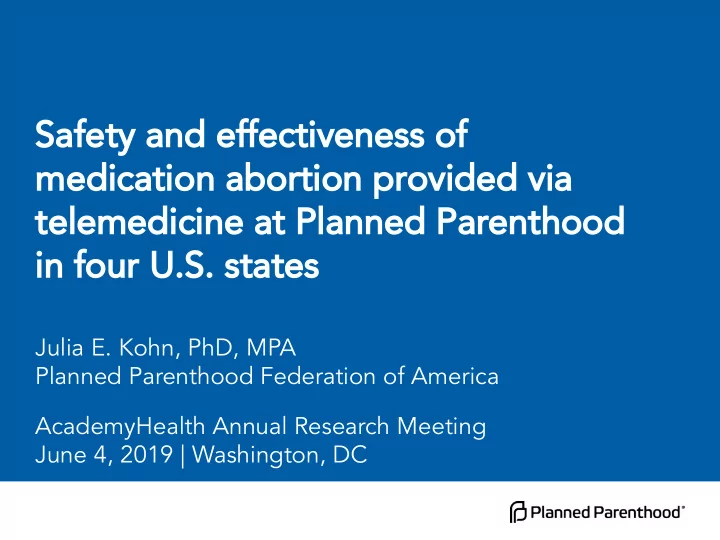

Safety and effectiveness of medication abortion provided via telemedicine at Planned Parenthood in four U.S. states Julia E. Kohn, PhD, MPA Planned Parenthood Federation of America AcademyHealth Annual Research Meeting June 4, 2019 | Washington, DC
Disclosures I have no financial relationships with any commercial interests to disclose.
Acknowledgments ● Co-authors : Jennifer L. Snow, MSc; Hannah R. Simons, DrPH; Jane W. Seymour, MPH; Terri-Ann Thompson, PhD; Daniel Grossman, MD ● Affi filiates: PP Great Northwest and the Hawaiian Islands and PP of the Rocky Mountains ● Anonymous Funder ● Patients
Telemedicine Continuum Consultation Site-to-Site Direct-to- Patient Connecting Connecting a Connecting a providers to provider to a provider to a each other in patient in a patient different different wherever locations health center they are
Background
Objective & Study Outcomes To assess outcomes of telemedicine medication abortion compared to standard medication abortion at Planned Parenthood health centers in four states ● Ongoing pregnancy ● Receipt of/referral for aspiration within 45 days ● Clinically-significant adverse events
Data Sources Retrospective cohort study using routinely-collected clinical data for patients at 26 Planned Parenthood centers in four states from April 2017–March 2018: Planned Parenthood Adverse event reports health center-specific submitted through internal EHR systems surveillance system AIMS
Analysis ● Compared outcomes between telemedicine and standard medication abortion groups: ○ Unit of analysis = abortion episode ○ Regression accounting for gestational age and health center clustering ○ Frequencies and rates of clinically-significant AEs ○ Sensitivity analyses applying published rates of ongoing pregnancy and aspiration
Sample 5,952 patients received a medication abortion 5,214 738 standard MAB tele MAB 4,011 (75%) 445 (60%) followed up with health followed up with health center within 45 days center within 45 days 4,456 (75%) patients with ascertainable outcomes
Patient Characteristics (N=5,952) ● State: Most (75%) from WA or NV (12%) ● Age: 56% in 20s (mean=27.5, SD=0.8) ● Race/ethnicity: 53% White, 14% Latina, 12% API; 11% Black ● GA: mean=49 days (SD=0.11) ● Parity: 49% were parous
Ongoing Pregnancy & Aspiration * All Standard TeleMAB AOR (n=4,456) (n=4,011) (n=445) (95%CI) 73 71 2 0.23 Ongoing (1.6%) (1.8%) (0.5%) (0.14–0.39) pregnancy Receipt or 188 182 6 0.28 referral for (4.2%) (4.5%) (1.4%) (0.17–0.46) aspiration *only includes patients with follow-up data within 45 days
Sensitivity Analysis All Standard TeleMAB OR* (N=5,952) (n=5,214) (n=738) (95%CI) Ongoing 86 82 4 0.34 Pregnancy (1.4%) (1.6%) (0.5%) (0.13–0.90) Receipt/ referral for 273 222 16 0.50 aspiration (4.0%) (4.3%) (2.2%) (0.30–0.83) *Estimated outcomes applying rates from Chen et al. (2015) to patients LTFU
Adverse Events All Standard TeleMAB (N=5,952) (n=5,214) (n=738) Any major AE or ED 17 16 visit with treatment (0.29%) (0.31%) 1 (0.14%) Any major AE 8 (0.13%) 7 (0.13%) 1 (0.14%) Hospital admission 4 (0.1%) 4 (0.1%) - Surgery 2 (<0.1%) 2 (<0.1%) - Transfusion 5 (0.1%) 4 (0.1%) 1 (0.1%) ED Visit treatment (minor AE) 9 (0.15%) 9 (0.17%) -
Limitations ● Loss-to-follow-up and differences by group ● Patients may have sought care at other providers or hospitals ● Uneven distribution across states; unable to conduct comparisons by state ● Used referral for aspiration for two sites and cannot be certain that all received procedure
Conclusions ● Findings support existing evidence that teleMAB results in comparable outcomes to standard medication abortion. ● Differences in observed rates may be due to differential follow up. ● To the extent that state bans on telemedicine for abortion rest upon arguments of improved patient safety, research findings do not support such contentions.
Questions? Julia Kohn, PhD, MPA National Director, Research, Evaluation & Data Analytics Planned Parenthood Federation of America julia.kohn@ppfa.org
Recommend
More recommend